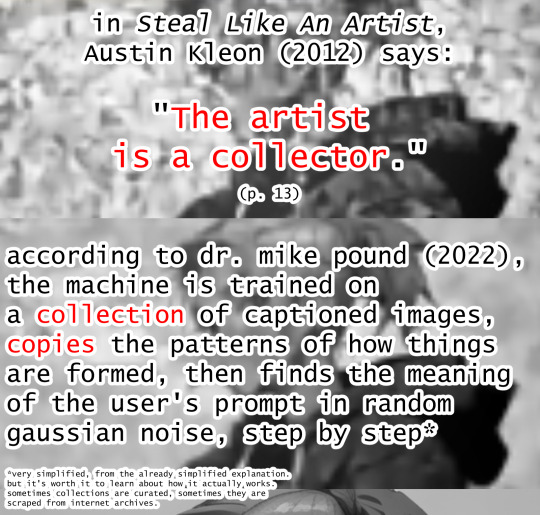#Conversational AI Tools
Explore tagged Tumblr posts
Text
Mastering the Art of Traffic & Leads with ChatGPT
Ever felt swamped by the need to create new content and draw in leads? I’ve been there. As a digital marketer, I spent hours brainstorming and planning. Then, I found ChatGPT, and it transformed my work. This AI tool changed how I market, create content, and get leads. ChatGPT is a smart AI from OpenAI. It can write emails, essays, and chat1. It’s not just a tool; it’s a big change for writers,…
#AI Chatbots for Traffic#AI-Powered Lead Conversion#ChatGPT for Business Growth#ChatGPT Marketing Solutions#Conversational AI Tools#Effective Lead Nurturing#Lead Generation Strategies#Personalized Customer Engagement#Traffic Optimization Techniques
0 notes
Text
Getting your info on AI purely from tumblr communists will really warp your brain. And I don't just mean the anti-AI tumblr communists, which most of them are. Pro-AI tumblr communists will talk about AI like "This is a tool for the radical collective ownership of art. We are taking a stance against the opressive capitalistic system of copyright that abuses artists for the benefit of large corporations. Art is owned by no one. Art is owned by everyone." And then you step into the real world and AI is being used as a copyright grift to siphon money from creators using youtube's absolutely broken content id. Youtube, of course, being owned by google; the massive multi-trillion dollar company that is investing billions into AI.
youtube
#ai#copyright#anti-ai#tumblr users: *points at giant tech conglomerates* is this anti-establishment and communist?#i mean my mutuals on tumblr dot gov hate it so it MUST be an opressed and countercultural tool that i have to fight to protect#sorry but 'noooo you are criticizing big tech WRONGLY you have to be MORALLY PERFECT while critiqueing this multibillion dollar industry–#or else you are HARMING SOCIALISM' is just not a very convincing argument to me.#yeah yeah i'm sure this tumblr blog was actually very regressive in their criticism of ai#self-policing must be our top priority in this conversation#socialism thanks you. as well as the private equity firms pumping billioms into this technology. two things that are perfectly compatible.
15 notes
·
View notes
Text
How AI & Machine Learning Are Changing UI/UX Design

Artificial Intelligence (AI) and Machine Learning (ML) are revolutionizing UI/UX design by making digital experiences more intelligent, adaptive, and user-centric. From personalized interfaces to automated design processes, AI is reshaping how designers create and enhance user experiences. In this blog, we explore the key ways AI and ML are transforming UI/UX design and what the future holds.
For more UI/UX trends and insights, visit Pixelizes Blog.
AI-Driven Personalization
One of the biggest changes AI has brought to UI/UX design is hyper-personalization. By analyzing user behavior, AI can tailor content, recommendations, and layouts to individual preferences, creating a more engaging experience.
How It Works:
AI analyzes user interactions, including clicks, time spent, and preferences.
Dynamic UI adjustments ensure users see what’s most relevant to them.
Personalized recommendations, like Netflix suggesting shows or e-commerce platforms curating product lists.
Smart Chatbots & Conversational UI
AI-powered chatbots have revolutionized customer interactions by offering real-time, intelligent responses. They enhance UX by providing 24/7 support, answering FAQs, and guiding users seamlessly through applications or websites.
Examples:
Virtual assistants like Siri, Alexa, and Google Assistant.
AI chatbots in banking, e-commerce, and healthcare.
NLP-powered bots that understand user intent and sentiment.
Predictive UX: Anticipating User Needs
Predictive UX leverages ML algorithms to anticipate user actions before they happen, streamlining interactions and reducing friction.
Real-World Applications:
Smart search suggestions (e.g., Google, Amazon, Spotify).
AI-powered auto-fill forms that reduce typing effort.
Anticipatory design like Google Maps estimating destinations.
AI-Powered UI Design Automation
AI is streamlining design workflows by automating repetitive tasks, allowing designers to focus on creativity and innovation.
Key AI-Powered Tools:
Adobe Sensei: Automates image editing, tagging, and design suggestions.
Figma AI Plugins & Sketch: Generate elements based on user input.
UX Writing Assistants that enhance microcopy with NLP.
Voice & Gesture-Based Interactions
With AI advancements, voice and gesture control are becoming standard features in UI/UX design, offering more intuitive, hands-free interactions.
Examples:
Voice commands via Google Assistant, Siri, Alexa.
Gesture-based UI on smart TVs, AR/VR devices.
Facial recognition & biometric authentication for secure logins.
AI in Accessibility & Inclusive Design
AI is making digital products more accessible to users with disabilities by enabling assistive technologies and improving UX for all.
How AI Enhances Accessibility:
Voice-to-text and text-to-speech via Google Accessibility.
Alt-text generation for visually impaired users.
Automated color contrast adjustments for better readability.
Sentiment Analysis for Improved UX
AI-powered sentiment analysis tools track user emotions through feedback, reviews, and interactions, helping designers refine UX strategies.
Uses of Sentiment Analysis:
Detecting frustration points in customer feedback.
Optimizing UI elements based on emotional responses.
Enhancing A/B testing insights with AI-driven analytics.
Future of AI in UI/UX: What’s Next?
As AI and ML continue to evolve, UI/UX design will become more intuitive, adaptive, and human-centric. Future trends include:
AI-generated UI designs with minimal manual input.
Real-time, emotion-based UX adaptations.
Brain-computer interface (BCI) integrations for immersive experiences.
Final Thoughts
AI and ML are not replacing designers—they are empowering them to deliver smarter, faster, and more engaging experiences. As we move into a future dominated by intelligent interfaces, UI/UX designers must embrace AI-powered design methodologies to create more personalized, accessible, and��user-friendly digital products.
Explore more at Pixelizes.com for cutting-edge design insights, AI tools, and UX trends.
#AI in UX Design#Machine Learning UX#UX Personalization#Conversational UI#Predictive UX#AI Chatbots#Smart UX Tools#UI Automation#Voice UI Design#Inclusive UX Design#Sentiment Analysis in UX#Future of UX#AI UX Trends 2025#Figma AI Plugins#Accessibility with AI#Adaptive UI Design#UX Innovation#Human-Centered AI#Pixelizes Blog#UX Strategy
2 notes
·
View notes
Text
Features of Our AI To Human Text Converter
However, not all AI-generated text is fit for human consumption without some level of refinement. That's where the AI To Human Text Converter comes in, a free tool that turns robotic-sounding AI content into natural, human-readable text. Let's dive into the key features that make this tool an indispensable resource for anyone looking to humanize AI-generated text effortlessly.
1. Simple and User-Friendly Interface
One of the standout features of our AI To Human Text Converter is its simple, user-friendly interface. Many people shy away from using complex tools that require a steep learning curve. Fortunately, this converter is designed with ease of use in mind. The interface is intuitive, allowing users to quickly navigate the platform and convert their AI-generated text into human-like content within seconds. There's no need to struggle with confusing menus or spend time learning how to use the tool.
2. Safe and Secure to Use
Safety is paramount when it comes to using online tools, especially for text conversion. AI To Human Text Converter ensures that users' data is protected through secure browsing measures. The website is well-secured, minimizing any risks of data breaches or security threats. Whether you're a content creator, student, or professional, you can confidently use the tool without worrying about jeopardizing your safety.
3. Accurate Conversion of AI-Generated Content to Human-Like Text
The primary feature of the AI To Human Text Converter is its ability to transform AI-generated content into human-readable text. Utilizing advanced algorithms, the tool analyzes the input and produces an output that closely mimics the natural flow of human writing. Whether you're converting AI content for essays, blog posts, or marketing materials, this tool ensures the end result is clear, engaging, and free of robotic phrasing.
4. No Limitations – Unlimited Usage
One of the most attractive features of the AI To Human Text Converter is its unlimited usage policy. Unlike other tools that impose restrictions or require subscriptions after a certain number of conversions, our tool is completely free with no limitations. You can convert as much content as you need, whenever you need it. This makes it an ideal solution for content creators, bloggers, and students with large volumes of AI-generated text to convert.
5. Fast and Efficient Processing
Time is a valuable commodity, and with our AI to human text converter, speed is a top priority. The tool processes your content in seconds, delivering humanized text quickly and efficiently. Whether you have a single paragraph or an entire document to convert, you can trust that the tool will provide results without delays.
6. No Authentication Needed
Another significant advantage of AI To Human Text Converter is that you don’t need to create an account, sign up, or log in. The tool is ready for immediate use, allowing you to convert text as soon as you arrive at the website. This no-authentication feature ensures a hassle-free experience, making it easy for users to get started right away.
Why Choose AI To Human Text Converter?
If you're looking for a reliable and efficient way to humanize your AI-generated content, AI To Human Text Converter is the perfect choice. Here are some key reasons why you should consider using this tool:
Free of Cost: Our tool is completely free to use, with no hidden fees or subscription costs.
Unlimited Use: Convert as much AI content as you need without worrying about restrictions.
No Login Required: Enjoy immediate access to the tool without needing to create an account.
Fast Conversion: Save time with near-instant results that transform AI text into human-like content.
User-Friendly: The intuitive interface makes it easy for anyone to use, even without prior experience.
The AI To Human Text Converter is packed with features that make it an excellent choice for anyone looking to convert AI-generated content into natural, human-readable text. Its simple interface, fast processing, and unlimited usage ensure that you get the best results without any hassle. Plus, with top-notch security measures in place, you can use the tool confidently and safely. Whether you’re a student, content creator, or professional, this tool is designed to meet all your text conversion needs.
Try the AI To Human Text Converter today and experience the difference for yourself!
#AI to human text#AI to human text converter#human-readable text#convert AI-generated content#humanize AI text#free AI to human text converter#secure text converter#AI content converter#unlimited AI text conversion#AI text tool#AI text to human-readable content#convert AI text for essays#convert AI text for blog posts#no login required AI tool#fast AI text conversion#user-friendly AI text converter#free online AI to human text tool#secure browsing AI tool#advanced AI text conversion algorithms#AI content transformation#hassle-free AI content conversion#fast and efficient AI text tool#unlimited usage AI text converter#no subscription AI tool#AI text humanization tool
5 notes
·
View notes
Note
hey heads up that the post you reblogged from vangoghcore is AI "art"
yo!! ty to you and the 3 other people who sent me asks about this. i tagged the post so its clear that its AI generated
#thanks for letting me know everyone! i try to be careful but im often on tumblr late at night with no braincells left#im down to write a whole thing about my stance on AI art if anyone's curious#i work in the animation industry so ive had dozens of conversations about this w other professionals#but it basically boils down to: ai image generation is a tool that can be very useful to us and also very dangerous to us#i think it should be regulated & used ethically but i dont want to deny its existence. i think it can be useful to brainstorm and find idea#among other things#rabicano#ask#that particular post feels ok to me cause its very obvious that its AI altho i wish OP had put it in the desc and not just in tags
13 notes
·
View notes
Text
Well in the end it comes down to recognizing when you can’t have a good faith conversation. I can understand the arguments being made and where it comes from but I fundamentally disagree with some of the foundations of these beliefs and will not budge. Nuance necessitates some alignment, I think.
#my ramblings#at this moment I don’t think you can separate the conversation of ai as a tool from the CURRENT ONGOING ethical issues#this isn’t theoretical it is right now for real being used in a specific way#if you’re curating your own datasets (??) for training (???) obviously there are ways to address it#but the major tools being used#are largely unethical full stop#and go beyond ‘unethical but you kind of can accept it and it’s necessary for day-to-day life’#in my opinion at least#there are ai tools that can be used without exploiting artists#like yknow filters or some of those color tools or van gogh generator#van gogh’s dead so it’s not really exploitation of his art unless it’s like. I dunno. sold as if it were a commission#instead of an ai generated product#plus I feel like some of the arguments I’ve read frame things in kinda weird way#like artists are gatekeeping art rather than developing their skills#and there are unproductive ways to frame arguments that raise concerns about ai#but making it about the argument rather than the tool is missing the forest for the trees#well yknow how it is#I simply won’t see those takes anymore
9 notes
·
View notes
Text
Had a work meeting yesterday for an indie shoot and the subject of AI came up and it felt like they were very dismissive of the WGA strike and AI art. And it boggles the mind— that as creatives, writers and artists yourselves that you don’t see how it won’t impact you.
#also my co-writer always does this shit#bringing up private conversations and debates that wasn’t meant to be shared with others#like I do think AI can be useful as tools#but not while it’s stealing from us to learn#while making the tech bros money#nonsims#fuck ai art#fuck ai writing
3 notes
·
View notes
Text
At the California Institute of the Arts, it all started with a videoconference between the registrar’s office and a nonprofit.
One of the nonprofit’s representatives had enabled an AI note-taking tool from Read AI. At the end of the meeting, it emailed a summary to all attendees, said Allan Chen, the institute’s chief technology officer. They could have a copy of the notes, if they wanted — they just needed to create their own account.
Next thing Chen knew, Read AI’s bot had popped up inabout a dozen of his meetings over a one-week span. It was in one-on-one check-ins. Project meetings. “Everything.”
The spread “was very aggressive,” recalled Chen, who also serves as vice president for institute technology. And it “took us by surprise.”
The scenariounderscores a growing challenge for colleges: Tech adoption and experimentation among students, faculty, and staff — especially as it pertains to AI — are outpacing institutions’ governance of these technologies and may even violate their data-privacy and security policies.
That has been the case with note-taking tools from companies including Read AI, Otter.ai, and Fireflies.ai.They can integrate with platforms like Zoom, Google Meet, and Microsoft Teamsto provide live transcriptions, meeting summaries, audio and video recordings, and other services.
Higher-ed interest in these products isn’t surprising.For those bogged down with virtual rendezvouses, a tool that can ingest long, winding conversations and spit outkey takeaways and action items is alluring. These services can also aid people with disabilities, including those who are deaf.
But the tools can quickly propagate unchecked across a university. They can auto-join any virtual meetings on a user’s calendar — even if that person is not in attendance. And that’s a concern, administrators say, if it means third-party productsthat an institution hasn’t reviewedmay be capturing and analyzing personal information, proprietary material, or confidential communications.
“What keeps me up at night is the ability for individual users to do things that are very powerful, but they don’t realize what they’re doing,” Chen said. “You may not realize you’re opening a can of worms.“
The Chronicle documented both individual and universitywide instances of this trend. At Tidewater Community College, in Virginia, Heather Brown, an instructional designer, unwittingly gave Otter.ai’s tool access to her calendar, and it joined a Faculty Senate meeting she didn’t end up attending. “One of our [associate vice presidents] reached out to inform me,” she wrote in a message. “I was mortified!”
24K notes
·
View notes
Text
Stay ahead with the latest trends in AI agents. Learn how these autonomous tools are reshaping industries, from finance to healthcare.

Discover how AI agents are transforming industries with intelligent automation, boosting efficiency, and enabling smarter decision-making in 2025 and beyond.
#AI agents#autonomous AI agents#intelligent agents#AI automation#AI-powered tools#artificial intelligence agents#AI agents in business#AI customer service agents#AI agents for startups#AI automation for enterprises#AI virtual assistants#workflow automation#generative AI#AI trends 2025#future of AI#machine learning agents#conversational AI#AI task automation#how AI agents work#benefits of AI agents#best AI agents for productivity#using AI agents in business#AI agents for process automation#top AI agents tools
1 note
·
View note
Text
How Can I Turn Content Produced by AI into Content Written by Humans?
Transforming AI-generated content into human-written text can be a challenging task. While manually editing the content to make it sound more natural can be time-consuming, there's a more efficient solution available. The Online AI Text Converter Tool provides a quick and easy way to convert AI-generated content into human-like text.
Manual Transformation vs. Using the AI Text Converter Tool
Manually transforming AI-generated text involves editing the content to remove robotic phrasing, adjusting the tone, and ensuring readability. This process can be tedious and require significant effort, especially with large volumes of content.
In contrast, the Online AI Text Converter Tool simplifies this process. This free tool allows you to convert AI-generated text into natural-sounding human text with just a few clicks. It utilizes advanced algorithms to ensure that the converted content retains its original meaning while adopting a more human-like tone.
Benefits of Using the Online AI Text Converter Tool
Efficiency: Convert AI text in seconds instead of spending hours on manual edits.
Ease of Use: User-friendly interface that requires no special skills or training.
High Quality: Produces high-quality, human-like text that reads naturally.
Cost-Free: Available for free with unlimited use, no hidden fees.
Versatility: Suitable for various types of content, including essays, blog posts, and professional documents.
How to Use the Online AI Text Converter Tool
Using the AI Text Converter Tool is straightforward. Visit the website, paste your AI-generated content into the provided text box, and click the convert button. The tool will quickly transform your text into a human-readable format, ready for use.
In conclusion, if you need to efficiently convert AI-generated content into human-like text, the Online AI Text Converter Tool is an invaluable resource. It saves time, enhances content quality, and is free to use. Try it today and see how easy it is to turn AI text into compelling, human-readable content.
#AI-generated content#human-written text#Online AI Text Converter Tool#convert AI-generated content#human-like text#manual transformation#efficiency#ease of use#high-quality text#cost-free tool#versatile content conversion#AI text conversion#natural-sounding text#quick text transformation#human-readable content
3 notes
·
View notes
Text
AI is Driving Investment — But Entrepreneurs Need to be Careful With What They Claim
New Post has been published on https://thedigitalinsider.com/ai-is-driving-investment-but-entrepreneurs-need-to-be-careful-with-what-they-claim/
AI is Driving Investment — But Entrepreneurs Need to be Careful With What They Claim


Artificial intelligence (AI) remains one of the strongest drivers of venture capital investment, proving that the hype cycle isn’t even close to finished. According to a recent EY report, 37% of fundraising in the third quarter of 2024 was for AI-related companies, similar to second-quarter volume. Startups using AI are getting noticed for their ability to tackle big problems in robotics, automation, healthcare, logistics, and more. But the reality is that investors hear, “We’re using AI” all day. The degree to which entrepreneurs actually use it varies substantially. There is even backlash from investors, including a 31-page report by Goldman Sachs that questions how worthy AI is of investment.
The Federal Trade Commission (FTC) recently announced a crackdown on companies making deceptive AI claims. This “AI washing” — lobbing AI into marketing without backing it up — might grab attention, but it’s a fast track to losing credibility. Founders need to communicate clearly and honestly about how AI fits into their business. The focus has to be on actual innovation, not just chasing buzzwords.
It is critical to avoid situations like Theranos, where bold claims were made without substance, leading to severe consequences. The stakes are even higher with AI, as the technical complexity makes it harder to verify claims of how it’s used and easier for misuse to slip through. According to insurer Allianz, 38 AI-related securities class action lawsuits were filed between March 2020 and October 2024 — 13 of them came in 2024 alone.
AI’s appeal to investors isn’t just about technical sophistication. It’s about solving problems that matter and creating a real business. Founders who take shortcuts or exaggerate their AI capabilities risk alienating the very backers they’re trying to attract. With regulators sharpening their scrutiny and the market growing more discerning, delivering substance is essential.
AI’s broad reach
Artificial intelligence encompasses far more than the conversational AI tools that dominate headlines. Patrick Winston, the late computer scientist and professor at MIT, outlined the foundational elements of AI more than 30 years ago in his seminal textbook, “Artificial Intelligence.” Long before large language models captured the public’s imagination, AI was driving advancements in problem solving, quantitative reasoning, and algorithmic control. These roots highlight the diverse applications of AI beyond chatbots and natural language processing.
Consider the role of AI in robotics and computer vision. Simultaneous localization and mapping (SLAM), for example, is a groundbreaking technique enabling machines to navigate and interpret environments. It underpins critical autonomous systems and exemplifies AI’s capability to address complex technical challenges. While not as widely recognized as large language models, these advancements are just as transformative.
Fields such as speech recognition and computer vision, once considered AI innovations, have since matured into distinct disciplines, transforming industries in the process and, in many cases, losing the ‘AI’ label. Speech recognition has revolutionized accessibility and voice-driven interfaces, while computer vision powers advancements in areas like autonomous vehicles, medical imaging, face recognition, and retail analytics. For founders, this underscores the importance of articulating how their innovations fit within AI’s broader landscape. Demonstrating a nuanced understanding of AI’s scope enables startups to stand out in an increasingly competitive funding ecosystem for early-stage companies.
For instance, machine learning models can optimize supply chain logistics, predict equipment failures, or enable dynamic pricing strategies. These applications may not command the same attention as chatbots, but they offer immense value to industries focused on efficiency and innovation.
Speaking investors’ language
When communicating to founders how they use AI, founders should focus on measurable impacts, such as improved efficiency, better user outcomes, or unique technical advantages. Many investors are not deeply technical, so it’s essential to present AI capabilities in simple, accessible language. Explaining what the AI does, how it works, and why it matters builds trust and credibility.
Investors are growing weary of hearing the term “AI,” concerned that entrepreneurs are over-branding their ventures with the technology instead of how it helps them solve problems. AI has become table stakes in many industries, and its role should not be overstated in a company’s strategy.
Equally important is transparency. With the FTC cracking down on exaggerated AI claims, being truthful about what your technology can and cannot do is a necessity. Overstating capabilities might generate initial interest but can quickly backfire, leading to reputational damage or regulatory scrutiny.
Founders should also highlight how their use of AI aligns with broader market opportunities. For example, leveraging AI for predictive analytics, optimization, or decision-making systems can demonstrate foresight and innovation. These applications may not dominate headlines like chatbots, but they address real-world needs that resonate with investors.
Ultimately, it’s about presenting AI as a tool that drives value and solves pressing problems. By focusing on clear communication, honesty, and alignment with investor priorities, founders can position themselves as credible and forward-thinking leaders in the AI space.
#2024#Accessibility#ai#AI Investment#ai tools#ai washing#Analytics#applications#artificial#Artificial Intelligence#attention#automation#autonomous#autonomous systems#autonomous vehicles#Branding#Business#chatbots#command#communication#Companies#complexity#computer#Computer vision#conversational ai#Deceptive AI#driving#efficiency#Entrepreneur#equipment
0 notes
Text
Integrating AI Call Transcription into Your VoIP or CRM System
In today’s hyper-connected business environment, customer communication is one of the most valuable assets a company possesses. Every sales call, support ticket, or service request contains rich data that can improve business processes—if captured and analyzed properly. This is where AI call transcription becomes a game changer. By converting voice conversations into searchable, structured text, businesses can unlock powerful insights. The real value, however, comes when these capabilities are integrated directly into VoIP and CRM systems, streamlining operations and enhancing customer experiences.
Why AI Call Transcription Matters
AI call transcription leverages advanced technologies such as Automatic Speech Recognition (ASR) and Natural Language Processing (NLP) to convert real-time or recorded voice conversations into text. These transcripts can then be used for:
Compliance and auditing
Agent performance evaluation
Customer sentiment analysis
CRM data enrichment
Automated note-taking
Keyword tracking and lead scoring
Traditionally, analyzing calls was a manual and time-consuming task. AI makes this process scalable and real-time.
Key Components of AI Call Transcription Systems
Before diving into integration, it’s essential to understand the key components of an AI transcription pipeline:
Speech-to-Text Engine (ASR): Converts audio to raw text.
Speaker Diarization: Identifies and separates different speakers.
Timestamping: Tags text with time information for playback syncing.
Language Modeling: Uses NLP to enhance context, punctuation, and accuracy.
Post-processing Modules: Cleans up the transcript for readability.
APIs/SDKs: Interface for integration with external systems like CRMs or VoIP platforms.
Common Use Cases for VoIP + CRM + AI Transcription
The integration of AI transcription with VoIP and CRM platforms opens up a wide range of operational enhancements:
Sales teams: Automatically log conversations, extract deal-related data, and trigger follow-up tasks.
Customer support: Analyze tone, keywords, and escalation patterns for better agent training.
Compliance teams: Use searchable transcripts to verify adherence to legal and regulatory requirements.
Marketing teams: Mine conversation data for campaign insights, objections, and buying signals.
Step-by-Step: Integrating AI Call Transcription into VoIP Systems
Step 1: Capture the Audio Stream
Most modern VoIP systems like Twilio, RingCentral, Zoom Phone, or Aircall provide APIs or webhooks that allow you to:
Record calls in real time
Access audio streams post-call
Configure cloud storage for call files (MP3, WAV)
Ensure that you're adhering to legal and privacy regulations such as GDPR or HIPAA when capturing and storing call data.
Step 2: Choose an AI Transcription Provider
Several commercial and open-source options exist, including:
Google Speech-to-Text
AWS Transcribe
Microsoft Azure Speech
AssemblyAI
Deepgram
Whisper by OpenAI (open-source)
When selecting a provider, evaluate:
Language support
Real-time vs. batch processing capabilities
Accuracy in noisy environments
Speaker diarization support
API response latency
Security/compliance features
Step 3: Transcribe the Audio
Using the API of your chosen ASR provider, submit the call recording. Many platforms allow streaming input for real-time use cases, or you can upload an audio file for asynchronous transcription.
Here’s a basic flow using an API:
python
CopyEdit
import requests
response = requests.post(
"https://api.transcriptionprovider.com/v1/transcribe",
headers={"Authorization": "Bearer YOUR_API_KEY"},
json={"audio_url": "https://storage.yourvoip.com/call123.wav"}
)
transcript = response.json()
The returned transcript typically includes speaker turns, timestamps, and a confidence score.
Step-by-Step: Integrating Transcription with CRM Systems
Once you’ve obtained the transcription, you can inject it into your CRM platform (e.g., Salesforce, HubSpot, Zoho, GoHighLevel) using their APIs.
Step 4: Map Transcripts to CRM Records
You’ll need to determine where and how transcripts should appear in your CRM:
Contact record timeline
Activity or task notes
Custom transcription field
Opportunity or deal notes
For example, in HubSpot:
python
CopyEdit
requests.post(
"https://api.hubapi.com/engagements/v1/engagements",
headers={"Authorization": "Bearer YOUR_HUBSPOT_TOKEN"},
json={
"engagement": {"active": True, "type": "NOTE"},
"associations": {"contactIds": [contact_id]},
"metadata": {"body": transcript_text}
}
)
Step 5: Automate Trigger-Based Actions
You can automate workflows based on keywords or intent in the transcript, such as:
Create follow-up tasks if "schedule demo" is mentioned
Alert a manager if "cancel account" is detected
Move deal stage if certain intent phrases are spoken
This is where NLP tagging or intent classification models can add value.
Advanced Features and Enhancements
1. Sentiment Analysis
Apply sentiment models to gauge caller mood and flag negative experiences for review.
2. Custom Vocabulary
Teach the transcription engine brand-specific terms, product names, or industry jargon for better accuracy.
3. Voice Biometrics
Authenticate speakers based on voiceprints for added security.
4. Real-Time Transcription
Show live captions during calls or video meetings for accessibility and note-taking.
Challenges to Consider
Privacy & Consent: Ensure callers are aware that calls are recorded and transcribed.
Data Storage: Securely store transcripts, especially when handling sensitive data.
Accuracy Limitations: Background noise, accents, or low-quality audio can degrade results.
System Compatibility: Some CRMs may require custom middleware or third-party plugins for integration.
Tools That Make It Easy
Zapier/Integromat: For non-developers to connect transcription services with CRMs.
Webhooks: Trigger events based on call status or new transcriptions.
CRM Plugins: Some platforms offer native transcription integrations.
Final Thoughts
Integrating AI call transcription into your VoIP and CRM systems can significantly boost your team’s productivity, improve customer relationships, and offer new layers of business intelligence. As the technology matures and becomes more accessible, now is the right time to embrace it.
With the right strategy and tools in place, what used to be fleeting conversations can now become a core part of your data-driven decision-making process.

#AI call transcription#VoIP integration#CRM integration#Speech-to-text software#Call transcription software#Real-time transcription#VoIP call recording#CRM automation#Customer call insights#Voice analytics#AI transcription for sales calls#Transcription in customer support#CRM call log automation#Automatic call summary#AI speech recognition tools#Sales call transcript analysis#Customer service call transcription#AI voice to text CRM#Call center compliance tools#Conversation intelligence software
0 notes
Text
👉👈 ive been trying my best... i think partly it helped to be poor, since i couldnt really get references done, so i was like "fine... ill do it myself". and seeing improvement has been... insane. ive been sometimes sad about my own art, but... some of the latest things actually working?? wheww
Appreciation post for all the beginner artists who work hard despite the AI looming over us. You are fabulous. You are precious. Keep up the hard work, you are needed.
#im also so jaded about ai#i start to think the world is terrible#i look at people made art#and its just... a breath of fresh air#a while back i went to a museum#i was having an ai convo beforehand#(pixel knows about this lmaoo. i be talking about it...)#and then i went into the painting exhibits#and i was speechless#its as if i was out of air#i kept looking so deeply#trying to think about how they mustve felt when making them#my friend went to school for art#so he was seeing the techniques and what they mustve been trying to do with the materials/tools#he got me talking#we both had different perspectives#but came together beautifully as we conversed about the paintings#it was a religious experience#art is so inherently *human*#not like. just on paper art. not just actual physically made art#but also the understanding of the beauty of things#like the sky when it dusks#yeah ai art can look “good” or whatever#but even if it does#thats not what art is *about*#maybe im rambling. maybe i lost the plot.#but there are cathedrals for everyone with eyes to see them#its not about just looking good. or about money. money is a good bonus (and art is a luxury that should be paid well)#but at the end of the day.the artist who made the work youre paying for put effort into it. and put effort into getting there to give you it#ccw rambles
57K notes
·
View notes
Text
AI-Driven Marketing: Set It & Forget It
AI-Driven Marketing Set It & Forget It 💡 Ever wish you could run Facebook & Google ads without hiring an expert? AI-powered ad management can optimize your budget and scale results! Marketing Without the Overwhelm: Is It Possible? Running ads sounds easy, until you actually start. One minute, you’re setting up a simple Facebook ad, and the next, you’re buried in audience targeting, budget…
#AI ad budget management#AI ad optimization#AI ad personalization#AI ad scaling#AI advertising tools#AI campaign automation#AI chatbot marketing#AI customer acquisition#AI email marketing optimization#AI for conversion optimization#AI for digital advertising#AI for Google Ads#AI for lead generation#AI for PPC advertising#AI for ROI maximization#AI for sales funnel automation#AI for small business marketing#AI in B2B marketing#AI in eCommerce marketing#AI in influencer marketing#AI in performance marketing#AI in social media marketing#AI marketing analytics#AI marketing automation#AI marketing intelligence#AI marketing strategy#AI marketing tools for entrepreneurs#AI marketing workflow automation#AI predictive analytics#AI social media ads
0 notes
Text
Boosting Online Course Sales with AI-Generated Landing Pages
Creating high-converting landing pages for your online course is one of the most crucial elements in boosting sales. But with the growing competition and changing customer preferences, the traditional methods may not always cut it anymore. This is where AI-generated landing pages come into play. In this article, we’ll explore how using AI can supercharge your landing page design, increase…
#AI tools#AI-generated landing pages#conversion optimization#landing page design#online course sales
0 notes
Text
youtube
I recently watched this video essay that explains a bit about how exactly the AI uses references. It also adresses some other issues people have with AI (the energy/water use issue for example) It's definitely made me think.
This is another video i watched from Doug Doug, explaining how AI in general works (not the image generating ones specifically though, he tries to explain ChatGPT AI in a simplified way):
youtube












"Original" Sin is what i've titled this piece. by me. sorry if you don't have "collapse long posts" enabled. I have many thoughts.
Transcript - References
#i think even after the videos tho#in our current system and with the way ppl are currently abusing these tools#it's still really harmful#even if the AI tools themselves aren't nesessarily to blame for it#so idk maybe we have to shift the “anti AI” conversation in a different direction somehow#i'm not sure. i need to think about it more#Youtube
8K notes
·
View notes